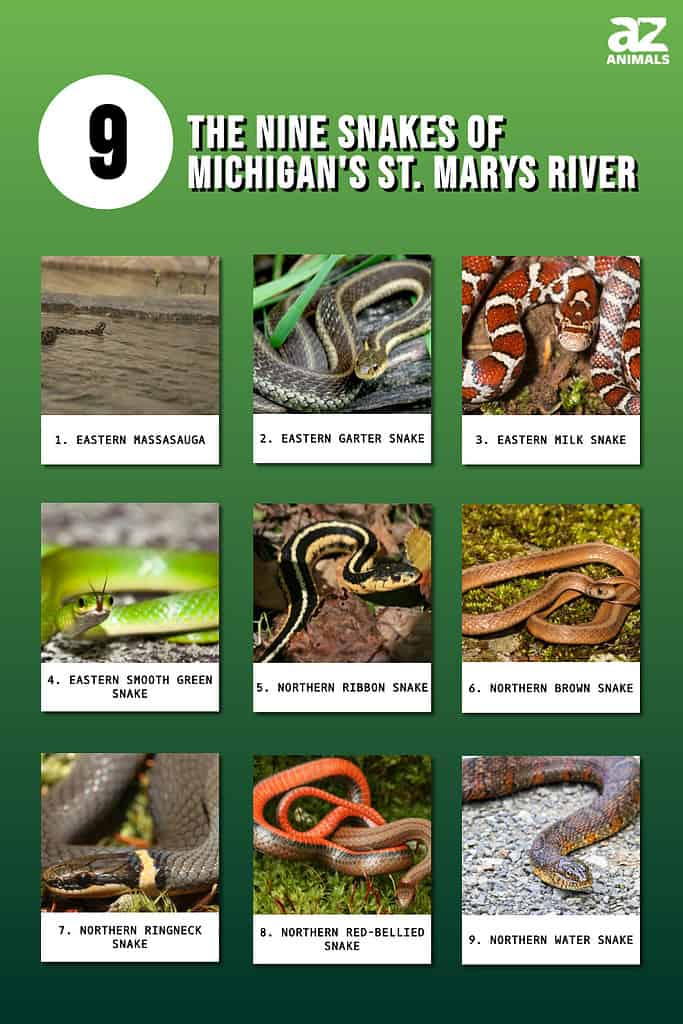
Nestled in the heart of Michigan’s Upper Peninsula, the St. Marys River flows between Lake Superior and Lake Huron, offering a diverse range of habitats for various species of wildlife. While many may associate this region with its stunning natural scenery and rich history, few are aware of the slithering residents that call this area home. The St. Marys River is home to a surprising variety of snake species, each with unique characteristics and behaviors that have helped them thrive in this northern landscape. From the elusive and venomous Eastern massasauga to the colorful Northern ringneck, these snakes have adapted to the region’s climate and terrain, playing an important role in the river’s ecosystem. Come along as we explore the fascinating world of the nine snakes in Michigan’s St. Marys River, shedding light on their lifestyles, habitats, and the importance of preserving these remarkable creatures.

The St. Marys River forms a border between the United States and Canada. The border flows through the middle of the river.
©ehrlif/Shutterstock.com
Eastern Massasauga (Sistrurus catenatus)
The Eastern massasauga (Sistrurus catenatus) is the only venomous snake species found in Michigan and it can be found in the St. Marys River area. The Eastern massasauga is a small, stocky rattlesnake that can grow up to 2 feet (60 cm) long. Its venom is primarily used for hunting small prey, such as mice and other rodents. While its venom is potent, the Eastern massasauga is a relatively docile snake and will typically avoid confrontation if possible. However, if threatened or cornered, it may strike in self-defense.
In Michigan, where the Eastern massasauga is the only venomous snake species, there are 1-2 bites reported each year. However, these snakes are generally not aggressive and will typically only bite if they feel threatened or cornered. Though the Eastern massasauga’s venom is relatively potent, they have short fangs that rarely deliver a large amount of venom. While a bite from this snake can be painful and may cause swelling and other symptoms, fatalities from Eastern Massasauga bites are extremely rare.
Of note: The Eastern massasauga is a protected species in Michigan and is considered threatened throughout its range. It is illegal to harm, harass, or kill this snake, and anyone who encounters an Eastern massasauga should leave it alone.

The Eastern massasauga is a protected species in Michigan and is considered threatened throughout its range.
©Ryan M. Bolton/Shutterstock.com
Safety Protocol
Should you find yourself face-to-face with an Eastern massasauga, it’s important to stay calm and take steps to avoid any potential conflict with the snake. Here are some tips on how to respond:
- Keep your distance: The Eastern massasauga is a shy and reclusive snake, and will generally try to avoid confrontation if possible. If you see one in the wild, give it plenty of space and avoid getting too close.
- Do not provoke or handle the snake: The Eastern massasauga is a venomous snake, and while its venom is rarely fatal to humans, it can cause pain, swelling, and difficulty breathing. Do not attempt to handle the snake or provoke it in any way.
- Back away slowly: If you find yourself in close proximity to an Eastern massasauga, slowly back away without turning your back on the snake. Move slowly and avoid sudden movements that could startle the snake.
- Seek medical attention if bitten: If you are bitten by an Eastern massasauga, seek medical attention immediately. The venom can cause symptoms such as pain, swelling, and difficulty breathing, and prompt treatment is important to minimize the effects of the venom.
- Remember that the Eastern massasauga, like all snakes, plays an important role in the ecosystem and should be respected and admired from a safe distance. With proper caution and respect, it is possible to coexist peacefully with these fascinating creatures.
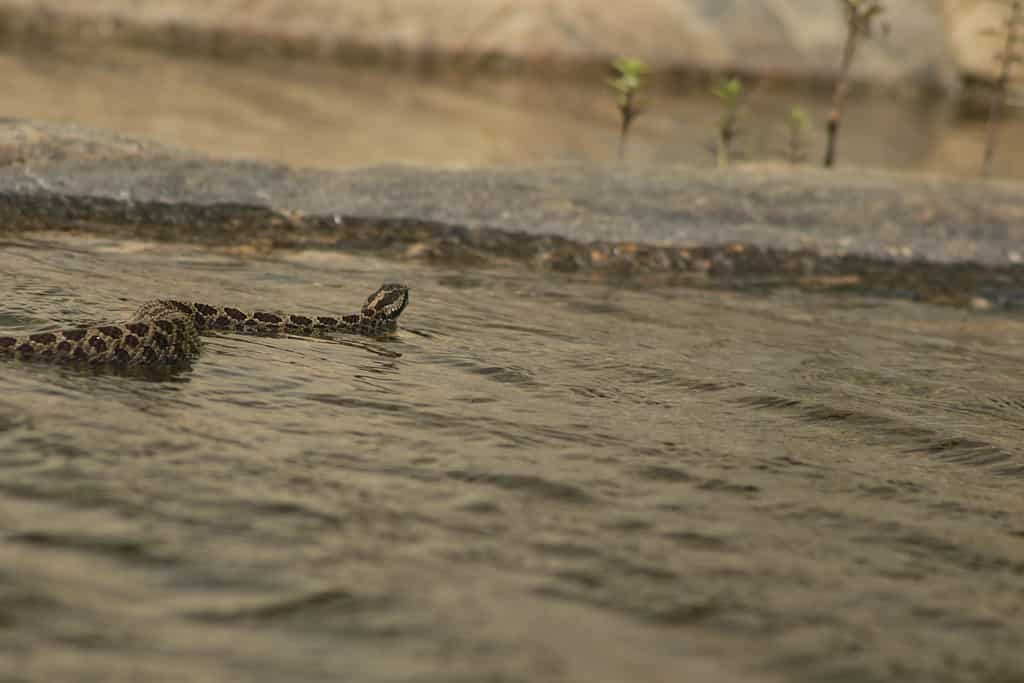
The Eastern massasauga is a shy and reclusive snake, and will generally try to avoid confrontation if possible.
©mynewturtle/Shutterstock.com
Eastern Garter Snake (Thamnophis sirtalis)
The Eastern garter snake (Thamnophis sirtalis) is another common snake species that can be found in Michigan’s St. Marys River region. These snakes are non-venomous and are recognized by their distinctive coloration, which includes longitudinal stripes running along the length of their bodies.
Eastern garter snakes are typically found in a variety of habitats, including wetlands, meadows, and forests. They are also known to be strong swimmers and may be found along the shoreline of the St. Marys River. These snakes are active during the day and feed on a variety of small prey, including insects, frogs, and small rodents. They are also known to eat other snake species, including other garter snakes. Eastern garter snakes are relatively docile and are unlikely to bite unless they feel threatened or cornered. Eastern garter snakes are capable of producing a mild venom that can stun small prey. However, this venom is not harmful to humans and is not considered dangerous.

Eastern garter snakes are recognized by their distinctive coloration, which includes longitudinal stripes running along the length of their bodies.
©Erik Agar/Shutterstock.com
Eastern Milk Snake (Lampropeltis triangulum)
The Eastern milk snake (Lampropeltis triangulum) is one of the snake species that can be found in Michigan’s St. Marys River region. Eastern milk snakes are relatively common throughout the Eastern United States, including Michigan. They are often found in wooded areas, grasslands, and rocky outcroppings, where they prey on small rodents, birds, and other small animals. In the St. Marys River region, Eastern milk snakes can be found in a variety of habitats, including forests, wetlands, and along the river’s shoreline.
These snakes are known for their striking coloration, which features a series of bold, reddish-brown blotches on a light body. They may also have a distinctive Y or V shape on the back of their head. Eastern milk snakes are typically shy and will often try to avoid confrontation if possible. If threatened, they may vibrate their tails and emit a musky odor in an attempt to deter predators.
Like many snake species, Eastern milk snakes help to control rodent populations and serve as a food source for larger predators. While they may occasionally come into contact with humans, they are generally harmless and should be left alone.
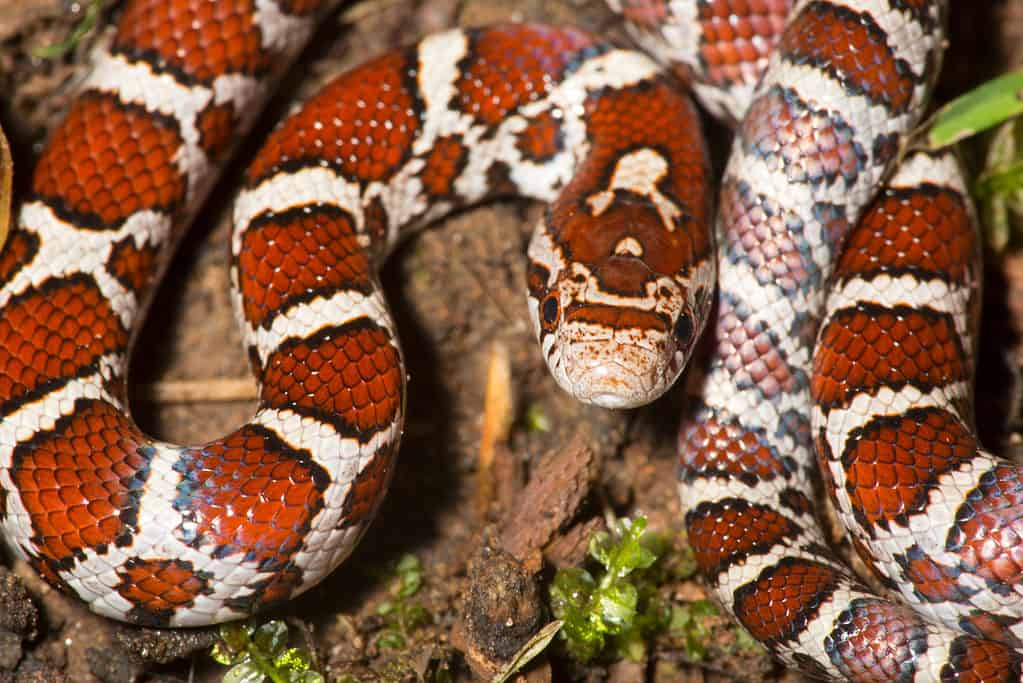
Eastern milk snakes are known for their striking coloration, which features a series of bold, reddish-brown blotches on a light body.
©Jeff Holcombe/Shutterstock.com
Eastern Smooth Green Snake (Opheodrys vernalis)
The Eastern smooth green snake (Opheodrys vernalis) also called a grass snake, is a non-venomous snake species. These snakes are small, slender, and have a distinctive bright green coloration on their backs, which helps them blend into their surroundings. Eastern smooth green snakes are typically found in areas with plenty of vegetation, such as grasslands, meadows, and wetlands. They feed primarily on insects, including grasshoppers, crickets, and other small arthropods.
These snakes are generally quite docile and will often flee if approached by humans or other potential predators. They may also emit a musky odor to deter predators. Despite their relatively small size, Eastern smooth green snakes help control insect populations and serve as a food source for larger predators.
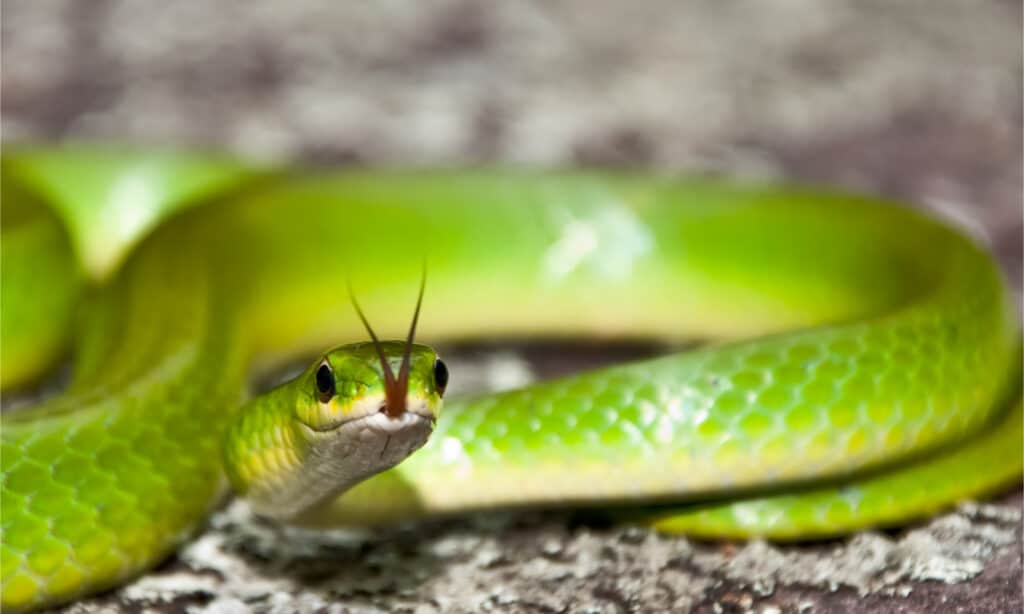
The Eastern smooth green snake (
Opheodrys vernalis) also called a grass snake, is a non-venomous snake species.
©Jay Ondreicka/Shutterstock.com
The Northern Ribbon Snake (Thamnophis sauritus septentrionalis)
The Northern ribbon snake (Thamnophis sauritus septentrionalis) is a slender, non-venomous snake species. They are named for their thin, ribbon-like appearance which is typically gray or brown with a series of longitudinal stripes along the length of their bodies. Northern ribbon snakes are typically found in areas with plenty of vegetation, including grasslands, meadows, and wetlands. They are also known to be strong swimmers and may be found near streams and rivers, including the St. Marys River.
Despite their relatively widespread distribution, Northern ribbon snakes are considered to be a species of concern in some parts of their range due to habitat loss. In Michigan, the population of Northern ribbon snakes is considered to be stable, but they are still at risk due to factors such as urbanization and the development of shoreline areas. Conservation efforts are underway to protect the Northern ribbon snake and its habitat.
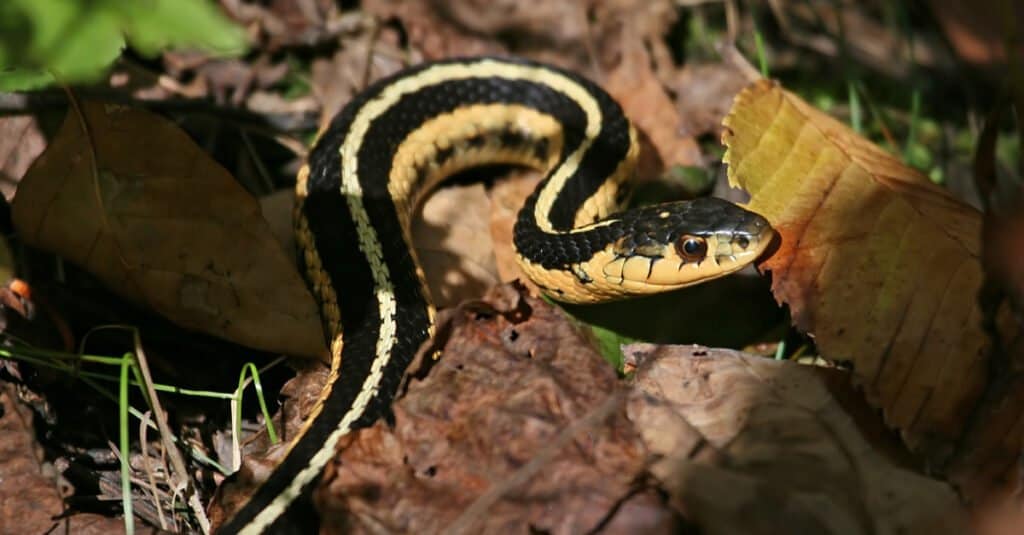
Northern ribbon snakes are named for their thin, ribbon-like appearance which is typically gray or brown with a series of longitudinal stripes along the length of their bodies.
©John Czenke/Shutterstock.com
Northern Brown Snake (Storeria dekayi)
The Northern brown snake (Storeria dekayi) is a small, non-venomous snake species. These snakes are named for their brown or grayish coloration, which helps them blend into their surroundings.
Northern brown snakes are usually found in areas with plenty of vegetation, such as forests, meadows, and wetlands. They are found under rocks, or logs where they hide from potential predators and hunt for small prey, such as insects and other invertebrates.
Despite their small stature, Northern brown snakes are important members of their ecosystem, helping to control pest populations and serving as a food source for larger predators. They are also relatively docile and are unlikely to bite unless they feel threatened or cornered.
Northern brown snakes are threatened by habitat loss and fragmentation, as well as other human activities such as road construction and development. Conservation efforts are underway to protect the Northern brown snake and its habitat, including the creation of protected areas and public education programs.
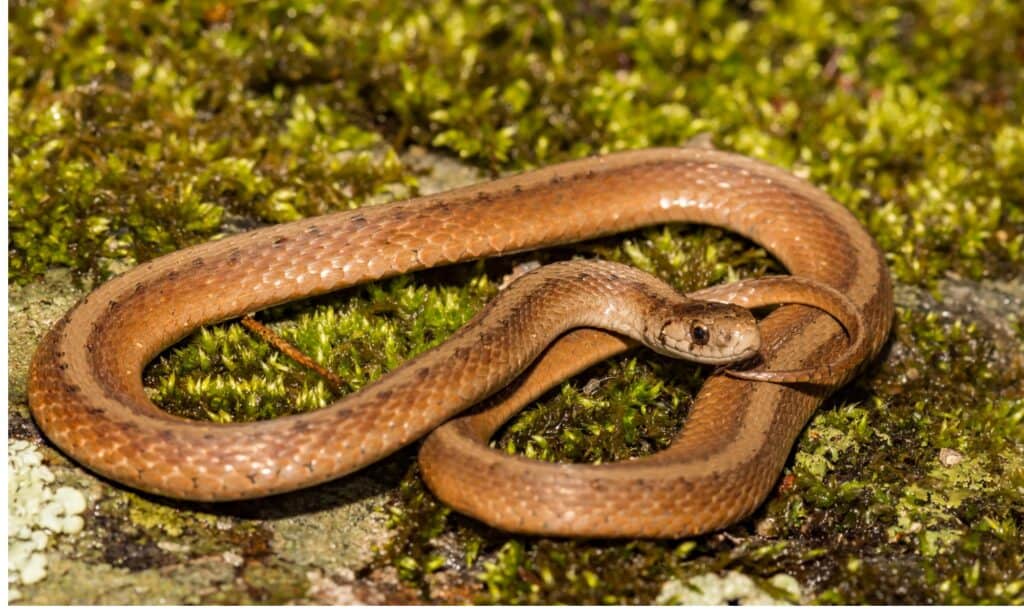
Northern brown snakes are threatened by habitat loss and fragmentation, as well as other human activities such as road construction and development.
©iStock.com/JasonOndreicka
Northern Ringneck Snake (Diadophis punctatus edwardsii)
The Northern ringneck snake (Diadophis punctatus edwardsii) is a small, non-venomous snake species. It is named for the yellow-orange ring found around its neck. Northern ringneck snakes are typically found in areas with plenty of vegetation, such as forests, meadows, and wetlands. They are often found under rocks, or logs hunting for small prey, such as insects, slugs, and other invertebrates. Northern ringneck snakes are important members of their ecosystem, helping to control pest populations and serving as a food source for larger predators. They are also relatively docile and are unlikely to bite unless they feel threatened or cornered.
In Michigan’s St. Marys River region, Northern ringneck snakes can be found in a variety of habitats, including forests, meadows, and wetlands. While they may occasionally come into contact with humans, they are generally harmless and should be left alone. Northern ringneck snakes are threatened by habitat loss and fragmentation from human activity. Efforts are underway to raise awareness about the importance of these snakes.
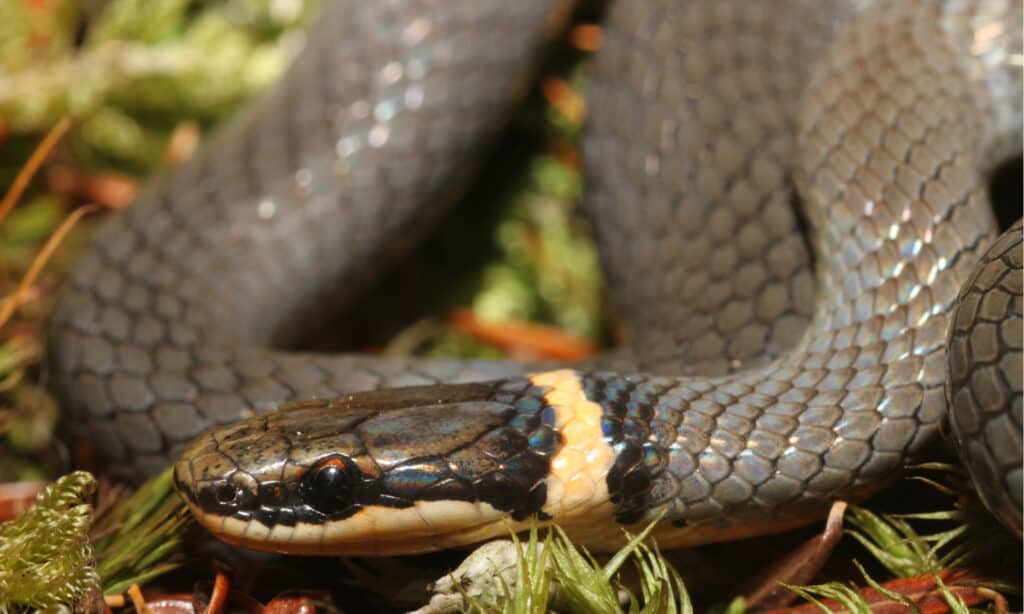
The Northern ringneck snake (
Diadophis punctatus edwardsii) is named for the yellow-orange ring found around its neck.
©/Shutterstock.com
Northern Red-bellied Snake (Storeria occipitomaculata)
The Northern red-bellied snake (Storeria occipitomaculata) is a small, non-venomous snake species These snakes are named for the distinctive red coloration found on their bellies, which contrasts with their brown or grayish backs. Northern red-bellied snakes are found in areas with plenty of vegetation, such as forests, meadows, and wetlands. They are often found under rocks or logs, hiding from potential predators and hunting for small prey, such as insects and other invertebrates.
These snakes are relatively docile and are unlikely to bite unless they feel threatened. They may also emit a musky odor in an attempt to deter predators.
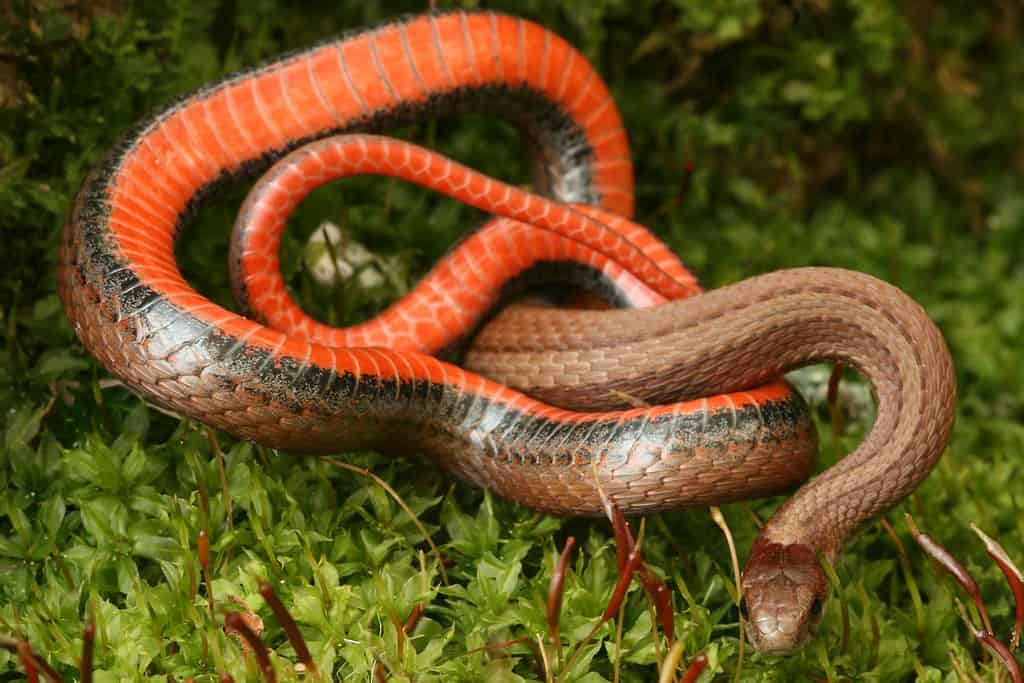
Red-bellied snakes are named for the distinctive red coloration found on their bellies, which contrasts with their brown or grayish backs.
©Kevin Collison/Shutterstock.com
Northern Water Snake (Nerodia sipedon)
The Northern water snake (Nerodia sipedon) is a medium-sized, non-venomous snake species that is found throughout much of North America, including Michigan’s St. Marys River region. These snakes are named for their semi-aquatic habits, as they are often found near bodies of water such as rivers, streams, and ponds. Northern water snakes are brown or gray in color, with red-to-orange cross bands on their bodies. They are active during the day and are often seen basking in the sun on rocks or logs near the water’s edge. They feed on a variety of prey, including fish, frogs, and other small aquatic animals.
Despite their relatively harmless nature, Northern water snakes are often mistaken for venomous snakes due to their aggressive behavior when threatened. They may flatten their bodies, hiss loudly, and strike repeatedly in an effort to defend themselves. However, their bites are non-venomous and rarely cause serious injury. Northern water snakes are an important part of the aquatic ecosystem, helping to control pest populations and serving as a food source for larger predators. They are also important indicators of water quality and habitat health.
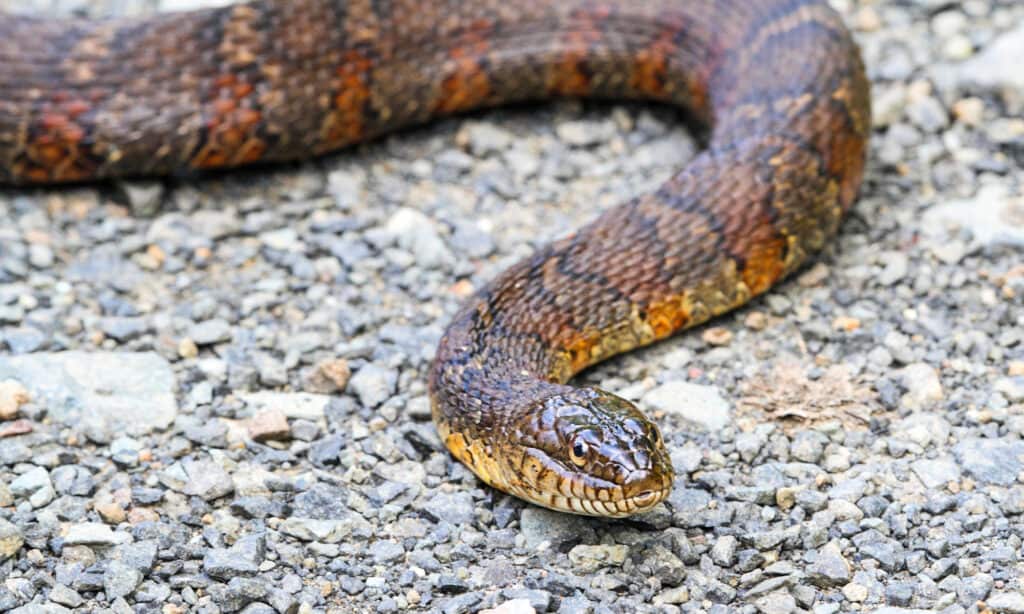
Northern water snakes are brown or gray in color, with red-to-orange cross bands on their bodies.
©Steve Byland/Shutterstock.com
Is it Safe to Swim in The St. Marys River?
Swimming in the St. Marys River can be safe, but it’s important to be aware of potential risks and take appropriate precautions. The river is generally considered safe for swimming in areas where there are no strong currents or boat traffic, and where the water is relatively clear.
However, there are some potential risks to be aware of. One of the primary concerns is the water temperature, which can be quite cold, especially in the early summer months. Swimmers should be prepared for the temperature and take steps to avoid hypothermia, such as wearing wetsuits or other protective gear. It is also important to be aware of boat traffic in the river, as boats and other watercraft can pose a risk to swimmers. Swimmers can avoid boats and other watercraft by swimming in designated swimming areas.

One of the primary concerns is the water temperature, which can be quite cold, especially in the early summer months.
©Cory Woodruff/Shutterstock.com
Wildlife around St. Marys River
The St. Marys River region is a rich and diverse ecosystem that is home to a wide variety of animal species. There is no shortage of fascinating wildlife to discover in this area in addition to the snakes that we have been discussing. Other notable animals that one might encounter in this area include:
- Bald eagles: These iconic birds are often seen soaring above the river, hunting for fish and other prey.
- Beavers: These industrious rodents are common in the wetlands along the river, where they build dams and lodges.
- River otters: These playful mammals can sometimes be seen swimming and playing in the river, and are known for their acrobatic abilities.
- White-tailed deer: These graceful animals are found throughout the region, and are often seen grazing in meadows or forest clearings.
- Black bears: While less common than some of the other animals on this list, black bears do inhabit the St. Marys River region, and may occasionally be seen by hikers or other outdoor enthusiasts.
- Gray wolves: These apex predators were once extirpated from Michigan but have since been reintroduced and can now be found in some areas of the Upper Peninsula, including near the St. Marys River.
- Moose: These large and iconic animals can be found in some areas of the Upper Peninsula, although sightings are rare.

River otters can sometimes be seen swimming and playing in the river, and are known for their acrobatic abilities.
©iStock.com/Mirko_Rosenau
Summary of the Nine Snakes of Michigan’s St. Marys River
| Rank | Snake |
|---|---|
| 1 | Eastern Massasauga |
| 2 | Eastern Garter Snake |
| 3 | Eastern Milk Snake |
| 4 | Eastern Smooth Green Snake |
| 5 | Northern Ribbon Snake |
| 6 | Northern Brown Snake |
| 7 | Northern Ringneck Snake |
| 8 | Northern Red-bellied Snake |
| 9 | Northern Water Snake |
The photo featured at the top of this post is © Jay Ondreicka/Shutterstock.com
Discover the "Monster" Snake 5X Bigger than an Anaconda
Every day A-Z Animals sends out some of the most incredible facts in the world from our free newsletter. Want to discover the 10 most beautiful snakes in the world, a "snake island" where you're never more than 3 feet from danger, or a "monster" snake 5X larger than an anaconda? Then sign up right now and you'll start receiving our daily newsletter absolutely free.
Thank you for reading! Have some feedback for us? Contact the AZ Animals editorial team.






